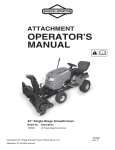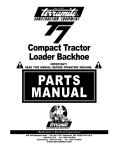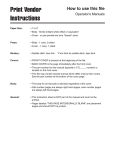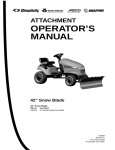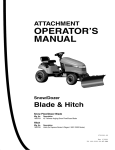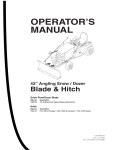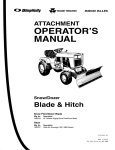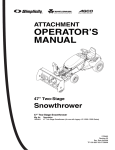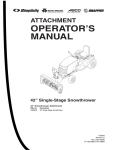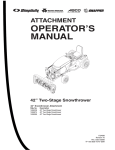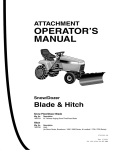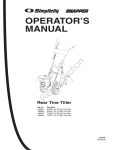Download Briggs & Stratton 1694919 Operator`s manual
Transcript
ATTACHMENT N ep o ro t fo du r ct io n OPERATOR’S MANUAL 42” Snow Blade R Mfg. No. 1694919 Description 42” Remote Angling Snow Blade 1732529-B Revision: B 2 N ep o ro t fo du r ct io n R Table of Contents 4 4 5 6 Assembly.. ...................................................................................... Initial Setup................................................................................ Install Reach on to Tractor ......................................................... Attach Lift Assembly to Snow Blade .......................................... Attach Snow Blade to Tractor..................................................... Install Snow Blade Arm ............................................................. Attche Control Arm Support Bracket to Tractor .......................... Operation ....................................................................................... Checks before Starting .............................................................. Engine and Ground Speed Selection ........................................ Transporting .............................................................................. Starting and Stopping ................................................................ Changing Angle of Blade........................................................... Snow Plowing Tips .................................................................... Operation ....................................................................................... Checks before Starting .............................................................. Snow Blade removal.................................................................. 7 7 8 9 9 10 11 12 12 12 12 12 12 12 12 12 12 Maintenance .................................................................................. Schedule for NormaL Care ........................................................ General Lubrication............................................................... Snow Blade Removal .................................................................... Travel Height Adjustment ........................................................... Snow Blade Removal ................................................................ Trouble Shooting ........................................................................... 13 13 13 14 14 14 16 Storage ........................................................................................... 17 Warranty ......................................................................................... 18 R N ep o ro t fo du r ct io n Operator Safety ............................................................................. General Warnings ...................................................................... Safety Decals ............................................................................ Features and Controls .................................................................. NOTE: In these instructions, “left” and “right” are referenced from the operating position. 3 Operator Safety Read these safety rules and follow them closely. Failure to obey these rules could result in loss of control of unit, severe personal injury or death to you, or bystanders, or damage to property or equipment. The triangle in text signifies important cautions or warnings which must be followed. GENERAL WARNING WARNING • Know the unit’s controls and how to stop quickly. READ THE OPERATOR’S MANUALS. • Read and obey all safety decals. • Only allow responsible adults, who are familiar with the instructions, to operate the unit. • Disengage the PTO. Shut off the engine and wait for all moving parts to stop before attaching, adjusting, or disconnecting any part of the collection system. • Use only attachments or accessories designed for your machine. See your dealer for a complete list of recommended attachments or accessories. • Keep the area of operation clear of all persons, particularly small children, and pets. Before leaving the operator’s position for any reason, engage the parking brake, disengage the PTO, stop the engine and remove the key. To reduce fire hazard, keep the engine, rider and mower free of grass, leaves and excess grease. Do not stop or park rider over dry leaves, grass or combustible materials. CAUTION Before you begin operating the unit be certain you have read all of the safety and operational information of this instruction sheet, as well as the Operator’s Manual for the tractor and any other attachments. N ep o ro t fo du r ct io n • Never direct discharge towards bystanders. ALWAYS shut off the tractor. Disengage the PTO, and allow all moving parts to stop BEFORE disconnecting or clearing tube, or emptying catcher. • Make sure all hardware is secure and that dozer blade is in good operating condition. • Check to be sure all safety devices and shields are in place. • Check that all adjustments are correct before using this unit. • Gasoline is highly flammable. Follow all precautions listed in your tractor’s operator’s manual. • Always wear eye protection while operating and performing adjustments to protect eyes from debris thrown by the dozer. • Turn off the PTO to disengage the blades when not mowing. R • DO NOT mow in reverse unless absolutely necessary. Always look down and behind before and while travelling in reverse. • DO NOT turn sharply when travelling alongside a building or any object. Slow down before turning. • DO NOT carry passengers. • For added stability and to prevent tipping or loss of control: a. Use reduced speed on uneven ground and when turning corners. b. Reduce loads on hillsides. It is recommended that the collection system be kept only half full when negotiating any slopes. Start mowing on slopes when the collection system is empty. c. Mow up and down the face of slopes; never across the face of any slope. • Never operate on slopes greater than 17.6% (10°). 4 Operator Safety Safety Decals PREPARATION • Disengage the PTO before making any adjustments. • Never attempt to make any adjustments while engine is running. • Thoroughly inspect the area where the dozer is to be operated and remove all foreign objects. • Adjust the skid shoe height to clear gravel or crushed stone surface. See the Adjustments section for procedure. Several safety labels are installed on the unit to remind you of important information while you are operating your unit. All DANGER, WARNING, CAUTION and instructional messages on your rider, attachments and mower should be carefully read and obeyed. Personal bodily injury can result when these instructions are not followed. The safety decals below are on your product. If any decals are lost or damaged, replace them at once. See your local dealer for replacements. These labels are easily applied and will act as a constant visual reminder to you, and others who may use the equipment, to follow the safety instructions necessary for safe, effective operation. PREPARATION • Always clear snow up and down the face of slopes, never across the face. Exercise extreme caution when changing direction on slopes. Do not attempt to clear steep slopes. WARNING Thrown Objects Hazard WARNING Thrown objects hazard • Objects thrown by the mower can seriously injure or kill you. N ep o ro t fo du r ct io n • Exercise extreme caution when operating on, or crossing, gravel drives, walks or roads. Stay alert for hidden hazards or traffic. Attachment Decal • After striking an object or if unit starts to vibrate abnormally, stop the engine and remove the key. Check for the cause and any damage before restarting. Before any inspection, make sure all moving parts have stopped. • Do not open the hopper while the mower blades are turning. • Do not operate the mower without the complete catcher in place. 1732819 • Take all possible precautions before leaving operator’s position. Lower the attachment, set the parking brake, stop the engine and remove the key. • Never operate near glass enclosures, automobiles, window wells, dropoffs, etc. • Do not put hands or feet near or under the dozer blade. Keep clear of the dozer blade at all times. • Do not overload machine capacity by attempting to clear too much material at too fast a rate. R • Never operate unit at high transport speeds on slippery surfaces. Use care when travelling in reverse. • Never operate the dozer blade without good visibility or light. Always be sure your feet are properly placed on the footrests and keep a firm hold on the steering wheel. • Do not run the engine indoors. • Never allow anyone in front of the unit. 5 Features & Controls WARNING A Before you begin operating the tractor with the dozer blade attachment, make certain you have: • Read and understood the instructions in the tractor Operator’s Manual. • Become thoroughly familiar with all of the tractor controls and their operation, including how to safely and properly start and stop the unit. • Practice driving in an open area—without dozing—to become accustomed to the unit. Control Functions The information below briefly describes the function of individual controls. Operating the tractor and dozer require the combined use of these controls and additional controls whose operation is described in the tractor Operator’s Manual. Blade Angle Control Lever N ep o ro t fo du r ct io n Please Take a moment and familiarize yourself with the name, location, and function of these controls so that you will better understand the safety and operating instructions provided in this manual. The blade angle release lever (A, Figure 1) controls a spring-loaded plate which locks the blade in one of three positions. Turn the lever counterclockwise to release the angling mechanism and move the blade left or right. Push the angling lever forward fully to lock the blade in the left position. Pull the lever fully back to lock the blade in the right position. Move the lever slowly past center to lock in the centered position. Attachment Lift R NOTE: It is easier to change the angle of the blade with the attachment raised. The attachment lift lever (B, Figure 1) raises and lowers the dozer blade. To RAISE attachment pull back on lever. To LOWER an attachment, move the lever forward. 6 Figure 1 B Assembly 21 17 20 4 26 5 29 18 20 22 2 2 3 1 * 6 7 27 19 2 28 24 16 2 8 9 N ep o ro t fo du r ct io n 15 10 13 11 23 25 13 14 Figure 2 Initial Setup Ref 1 2 3 4 5 6 7 8 9 10 11 12 13 14 15 Qty 1 7 1 1 1 1 1 1 1 2 1 2 2 1 1 R 12 Description Extension Spring Hair Pin Flat Washer Lift Rod Assembly Lift Pivot Lock Washer .875” Cap Screw Reach Bell Crank Latch Rod Hitch Lift Assembly 1.25” Cap Screw Nut Snow Blade Assembly Spring Ref 16 17 18 19 20 21 22 23 24 25 26 27 28 29 * Qty Description 1 1 1 3 3 1 1 2 2 2 1 1 1 1 1 Long Eye Bolt Short Eye Bolt Bottom Blade Rod 1.00” Cap Screw Flange Nut Top Blade Rod Control Arm Support Bracket Washer Hex Nut Spacer Large Hair Pin Reach Support Rod Cotter Pin Lock Nut “C” Lift Rod (Part tractor lift assembly) 7 Assembly Install Reach on to Tractor 1. Remove mower deck. 2. On right side of reach (A, Figure 3), install the bell crank (B) through the front holes . 6. Slide the reach (A, Figure 5) under tractor and lift to slide reach mounting arms (B) over reach support shaft (C). 3. Place reach on floor in front of tractor, with the hitch mounting arms towards the rear of the tractor. B A A C B Figure 3 N ep o ro t fo du r ct io n Figure 5 4. On underside of tractor frame, insert reach support rod (A, Figure 4) as shown and secure with the cotter pin (B) on inside of frame. IMPORTANT: The cotter pin must be located along the inside edge of the tractor frame. 5. Slightly bend longer end of cotter pin. See Figure 4 inset. 7. At front of the machine, locate latch rod (A, Figure 6) and remove hair pin (B) and slide out of reach (C). 8. Turn the front wheels fully to the left. 9. Lift the reach (C) and place the latch rod (D) onto the tractor frame support fingers (E). 10. From the left side of the tractor, re-install latch rod (A) through the holes on each side of reach. 11. Secure the latch rod (A) with the hair clip (B). NOTE: Keep the handle portion of the hitch latch pin towards the front of the tractor. R E A A B B D C B Figure 4 Figure 6 8 Assembly Attaching Hitch Lift Assembly to Snow Blade 1. Attach the hitch lift assembly (A, Figure 7) to snow blade assembly (B) using 1.25” cap screw (C), washer (D), spacer (E) and nut (F). 4. Insert the large loop of spring (A, Figure 9) through the hole (B) in hitch lift assembly and then the small loop through eyebolt (C). 5. Tighten the hex nuts (D) to adjust and apply tension to the spring. A D F E A D E F C B N ep o ro t fo du r ct io n B C Figure 9 Attaching Snow Blade to Tractor Figure 7 2. Secure the hex nut (A, Figure 8) onto long eyebolt (B). Tighten the eyebolt locknut toward top of threads. See Figure 8 inset. 3. Insert long eyebolt / locknut through the hole (C) at top of the blade and secure with additional hex nut (D). 1. Position snow blade assembly in front of tractor. NOTE: Make sure that the bell crank (A, Figure 10) is rotated to a 45° angle before installing the snow blade assembly as shown in inset. 2. Align mounting holes on snow blade frame with the mounting holes in the reach. 3. Insert latch rod (B) and secure with hair pin (C). A R B A 45° C B C D Figure 8 Figure 10 9 Assembly Install Snow Blade Lift Arm Note: The following steps are preformed under right rear fender. 1. Move the mower deck lift arm to the “LOWERED” position. 4. Install the extension spring (A, Figure 13) into square hole (B) at the rear edge of the tractor frame. 5. Secure the other end of extension spring to the “C” lift rod (C) on the mower deck lift arm. 2. Insert .875” cap screw (A, Figure 11), lock washer (B) into top hole of mower lift arm (C). C B A A B C N ep o ro t fo du r ct io n Figure 13 6. Attach the lower ball joint (A, Figure 14) of lift rod assembly to the bell crank (S) and secure with the hair pin (C). Figure 11 3. Slide the lift pivot (D, Figure 12), lift rod assembly (E), and washer (F) onto cap screw (B) and secure large hair pin (G). Note: Make sure to position the washer between the hair pin and the lift arm. G Figure 12 10 E D B R F A Figure 14 B C Assembly Attaching Control Arm Support Bracket to Tractor 1. On right side of tractor, install the control arm support bracket (A, Figure 15) using a 1.00” cap screw (B) and flange nut (C) to the tractor frame. 2. On the outside of the control arm support bracket (A) install the short eye bolt (D), and secure with nut (E). E D 5. Slide the control arm assembly (A, Figure 18) through the two adjustment arm joints (B). Secure the control arm with four hair pins (C). A C B B A Figure 18 6. Tighten ball joint locking nuts (A, Figure 19). C N ep o ro t fo du r ct io n Figure 15 3. Insert the top blade rod (A, Figure 16) through the eye bolt hole (B). A A A Figure 19 B R 7. Lower the blade to the ground and adjust the skid shoes. See Skid Shoe Adjustment, page 17. Figure 16 4. Attach the lower portion of the control arm (A, Figure 17) to the upper control arm (B) using the 1.00” cap screws (C) and lock nuts (D). C A B D Figure 17 11 Operations Transporting DANGER OPERATING ON SLOPES CAN BE DANGEROUS Never operate on slopes greater than 17.6% (10°) which is a rise of 3-1/2 feet (106cm) vertically in 10 feet (607cm) horizontally. Operate the unit at a slow ground speed when driving onto slope. Avoid using brakes to control ground speed. When operating on slopes that are greater than 15 % (8.5°) but less than 17.6%, use additional wheel weights or counterweights. In addition to counterweights, use extra caution when operating on slopes. Drive UP and DOWN the slope, never across the face, use caution when changing directions and DO NOT START OR STOP ON SLOPE. For additional traction, tire chains and a weight box can be added. Maximum weight added to tractor should not exceed 35 lbs. per wheel and 100 additional lbs. in weight box. WARNING Perform the Safety System Interlock test found in your tractor Operator’s Manual. If tractor does not pass the test, do not operate the tractor. See your authorized dealer. Under no circumstances should you attempt to defeat the safety system. Use caution when plowing a snow covered area. Snow can cover objects such as curbs, drop-offs, and other obstacles. Be familiar with the area you are plowing. To prevent an explosion or fire, never store the tractor with fuel in the tank inside a building where an ignition source is present. Checks Before Starting R 1. Refer to the Maintenance & Adjustments sections of this manual and perform any needed service. Also, refer to the tractor Operator’s Manual and perform any required service. 2. Remove any objects from the work area which might interfere with plowing activity. 3. Adjust the skid shoes to desired height. See Skid Shoe Adjustment. 4. Make sure all hardware is present and secure. Engine & Ground Speed Selection Always run the engine at full throttle. Set tractor speed to obtain the needed power to move the material. Operate at a safe speed, depending on conditions, so that you have complete control of the tractor. Rear wheel weights and chains are recommended for slippery surfaces. A rear weight carrier is recommended for additional traction. 12 Starting & Stopping 1. Start the tractor engine. Set engine throttle to full. 2. Raise the attachment lift and travel to the work site. 3. Set the angling control to the desired angle. 4. Lower the attachment lift and begin plowing. 5. Raise the plow before backing up. 6. To stop the tractor, set ground speed to neutral and set the parking brake. Before leaving the seat, stop the engine, set the parking brake, remove the key, and wait for all moving parts to stop. Changing Angle of the Blade: See Figure 1 for location of Controls. NOTE: It is easier to change the angle of the blade with the attachment raised. N ep o ro t fo du r ct io n IMPORTANT Note: To prevent damage to the unit, always raise the dozer blade BEFORE turning or backing up. For maximum ground clearance, transport the blade to and from work areas fully raised and angled straight ahead. 1. Raise the attachment lift. 2. Turn the lever counterclockwise to release the angling mechanism and move the blade left or right. Push the angling lever forward fully to lock the blade in the left position. Pull the lever fully back to lock the blade in the right position. Move the lever slowly over center to lock in the centered position. Snow Plowing Tips • Determine the best snow removal pattern before beginning. • Plan the pattern so that you avoid pushing snow onto cleared areas. • When land contour permits, it is best to travel in the longest direction to minimize turning. • In very deep or heavy snow, it may be necessary to make the first pass with dozer blade partially raised, then repeat each pass with the blade lowered to clear the material left on the surface. Also, it may be necessary to clear less than the full width of the dozer blade or reduce ground speed. • Snow tends to freeze into solid banks when plowed off a driveway or other large area. Because of this you may want to plow snow several feet past the edge of the drive to allow space for future plowing to build up. • If pushing snow past the edges of driveways or sidewalks, be careful not to tear up the grass buried under snow next to the drive or sidewalk. Lift the blade several inches off the ground to avoid damaging the grass. • Spinning tires with tire chains can leave unsightly marks or permanent damage to asphalt or concrete driveways or sidewalks. Avoid sudden stops or starts. Figure 20 Schedule For Normal Care WARNING N ep o ro t fo du r ct io n Maintenance General Lubrication Schedule Clean snow and ice from the snow blade. After each use. Lubricate snow blade. Every 10 hours or at least once a year. R To avoid serious injury, perform maintenance on the unit only when the engine is stopped and all moving parts have stopped. Always remove the ignition key before beginning maintenance or adjustments to prevent accidental starting of the engine. Care Required Lubricate the snow blade as shown in Figure 21. Where an oil can is shown use 30 weight oil. Where a grease gun is shown, use lithium grease. Lubricate the following areas: • Grease the blade pivot. • Oil the blade lock pawl • Apply grease to the plastic wear surface above the bell crank and to the bell crank. 13 Snow Blade Removal Travel Height Adjustment 4. Remove the hair pin (A, Figure 23) from bell crank (B) and remove the lift arm assembly (C). CAUTION Make sure to shut off the engine and lock the tractor brakes or block the rear wheels before beginning the snow blade removal process. B 1. Fully raise the snow blade off the ground. If the transport height is not correct, lower the snow blade to the ground and remove the lift arm (A, Figure 21) from the bell crank (B). 2. Loosen the lift arm ball joint lock nut (C) and rotate the ball joint (A) either right or left to adjust the proper lift height. 3. Reinstall and secure the lift arm and test adjustment. Repeat as needed. A C Figure 23 N ep o ro t fo du r ct io n 5. Remove lift arm assembly (A, Figure 24) from the mower lift arm (B) by removing the hair pin (C) and flat washer (D). NOTE: Leave the lift pivot attached to the mower deck lift arm. B D C A Figure 21 Snow Blade Removal C 1. Lower the snow blade to the ground. 2. Remove the four (4) hair pins (A, Figure 22) from the control arm (B) from ball joints (C) and remove the control arm from the snow blade assembly. R A 3. Remove the control arm from the tractor. NOTE: The control arm support bracket can be left on the tractor. B A C Figure 22 14 Figure 24 B Snow Blade Removal 6. Turn the front wheels fully to the left. 7. Remove the hair pin (A, Figure 25) and slide the latch rod (B) out from the reach (C). CAUTION 9. At back of tractor, slide reach mounting arms (A, Figure 26) out of the reach support shaft (B). Slide the reach from under the tractor. NOTE: The reach support shaft (B) may be left in position and will not interfere with the operation of the lawn mower deck. Make sure to support the front of the hitch assembly as is will be loose when the latch rod has been removed. 8. Lift the reach (C) off the support fingers (D) and place front end of the reach onto the floor. D B B N ep o ro t fo du r ct io n C A C Figure 25 IMPORTANT Note: Inspect the snow blade assembly, hitch assembly, and all component parts for signs of wear or damage. Have these items repaired or serviced before reinstalling the snow blade onto the tractor. R B Figure 26 15 TroubleShooting Troubleshooting WARNING • To avoid serious injury, perform maintenance on the tractor or snow blade only when the engine is stopped and the parking brake engaged. • Always remove the ignition key, disconnect the spark plug wire and fasten it away from the plug before beginning the maintenance, to prevent accidental starting of the engine. PROBLEM While normal care and regular maintenance will extend the life of your equipment, prolonged or constant use may eventually require that service be performed to allow it to continue operating properly. The troubleshooting guide below lists the most common problems, their causes and remedies. See the information on the following pages for instructions on how to perform most of these minor adjustments and service repairs yourself. If you prefer, all of these procedures can be performed for you by your local authorized dealer. CAUSE/SOLUTION A. Clean ice or snow from lock and pivot mechanism. 1. Snow blade does not lock into position. B. Lubricate lock and pivot mechanism. C. Check return spring. B. Lift height out of adjustment. See ADJUSTMENTS section. N ep o ro t fo du r ct io n 2. Scraper bar does not clean down to hard surface. A. Skid shoes not properly adjusted. Adjust skid shoes. 3. Snow blade picks up stones on gravel drive 4. Tractor does not have sufficient traction. A. Skid shoes not properly adjusted for ground surface. Adjust skid shoes. A. Tractor too light at rear wheels. Use Quick Tach weights, wheel weights, and tire chains. A. Ground speed too fast. Reduce speed. 5. Tractor not stable on sloping surfaces. A. Tractor not properly weighted. See Recommended A. A. Accessories, page 1. 6. Snow blade lifts hard. 16 R A. Slope grade too steep. See Safety Section. Use Quick Tach weights, wheel weights, and tire chains. A. Skid shoes not properly adjusted. Adjust skid shoes. B. Lift height out of adjustment. See ADJUSTMENTS section. TroubleShooting Skid Shoe Adjustment Lift Adjustment On smooth surfaces such as concrete or asphalt, the scraper bar should scrape the surface. On surfaces such as gravel, the scraper bar should be set high enough so that it will not pick up debris. In the fully raised position the attachment should be 4”-5” off the ground. 1. Lower the snow blade and adjust the skid shoes to achieve the correct plowing height. 2. Loosen the nuts (A, Figure 27) securing the skid shoes (B). 3. Raise or lower the scraper bar to the desired height. Use wood blocks to hold the snow blade in position. 4. Set the skid shoes so that they are in contact with the ground and tighten the skid shoe nuts. 1. Fully raise the snow blade. The snow blade should be approximately 4”-5” off the ground. If not, go to step 2. 2. Lower the snow blade to the ground. 3. Remove hair pin (A, Figure 28) from the bell crank (B) on the lift rod assembly (C). 4. Remove the lift rod assembly (C) from from the bell crank (B). 4. Loosen the ball joint lock nut (D) and rotate the ball joint either counter clockwise to lower the travel height or clockwise to increase the travel height. Tighten the lock nut (D). 5. Reinstall the lift rod assembly (C) onto the bell crank (B) and secure with the hair pin (A). A 6. Raise the snow blade off the ground and check the travel height. B A C R Figure 27 N ep o ro t fo du r ct io n 7. Repeat as needed until the correct travel height is set. B A Figure 28 17 Storage IMPORTANT Note: Refer to Tractor Operator’s Manual for important information concerning safely storing your tractor. Daily Storage 1. Allow tractor engine to cool before storing in any enclosure. 2. After dozing or plowing jobs are completed, hose or brush down the blade to remove excess dirt. 3. Lightly oil all pivot points. Coat bare metal surfaces to prevent corrosion. Off-Season Storage 1. Remove dozer blade and hitch from the tractor. 2. Use water pressure or a brush to thoroughly clean the dozer blade. 3. Paint, or lightly coat with oil, any area where paint has been worn or chipped away. 4. Lubricate the dozer blade. R N ep o ro t fo du r ct io n 5. Store the dozer blade and hitch in a dry place. 18 Warranty LIMITED WARRANTY Briggs & Stratton Power Products Group, LLC will repair and/or replace, free of charge, any part(s) of the equipment that is defective in material or workmanship or both. Briggs & Stratton Corporation will repair and/or replace, free of charge, any part(s) of the Briggs and Stratton engine* (if equipped) that is defective in material or workmanship or both. Transportation charges on product submitted for repair or replacement under this warranty must be borne by purchaser. This warranty is effective for the time periods and subject to the conditions stated below. For warranty service, find the nearest Authorized Service Dealer using our dealer locator at www.BriggsandStratton.com. There is no other express warranty. Implied warranties, including those of merchantability and fitness for a particular purpose, are limited to one year from purchase or to the extent permitted by law. Liability for incidental or consequential damages are excluded to the extent exclusion is permitted by law. Some states or countries do not allow limitations on how long an implied warranty lasts, and some states or countries do not allow the exclusion or limitation of incidental or consequential damages, so the above limitation and exclusion may not apply to you. This warranty gives you specific legal rights and you may also have other rights which vary from state to state or country to country. WARRANTY PERIOD Item Equipment Consumer Use 1 Years Commercial Use: N/A ABOUT YOUR WARRANTY N ep o ro t fo du r ct io n The warranty period begins on the date of purchase by the first retail consumer or commercial end user, and continues for the period of time stated above. “Consumer use” means personal residential household use by a retail consumer. “Commercial use” means all other uses, including use for commercial, income producing or rental purposes. Once product has experienced commercial use, it shall thereafter be considered as commercial use for purposes of this warranty. No warranty registration is necessary to obtain warranty on Briggs & Stratton products. Save your proof of purchase receipt. If you do not provide proof of the initial purchase date at the time warranty service is requested, the manufacturing date of the product will be used to determine warranty eligibility. We welcome warranty repair and apologize to you for being inconvenienced. Warranty service is available only through R servicing dealers authorized by Briggs & Stratton or BSPPG, LLC. Most warranty repairs are handled routinely, but sometimes requests for warranty service may not be appropriate. This warranty only covers defects in materials or workmanship. It does not cover damage caused by improper use or abuse, improper maintenance or repair, normal wear and tear, or stale or unapproved fuel. Improper Use and Abuse - The proper, intended use of this product is described in the Operator’s Manual. Using the product in a way not described in the Operator’s Manual or using the product after it has been damaged will void your warranty. Warranty is not allowed if the serial number on the product has been removed or the product has been altered or modified in any way, or if the product has evidence of abuse such as impact damage, or water/chemical corrosion damage. Improper Maintenance or Repair - This product must be maintained according to the procedures and schedules provided in the Operator’s Manual, and serviced or repaired using genuine Briggs & Stratton parts. Damage caused by lack of maintenance or use of non-original parts is not covered by warranty. Normal Wear - Like all mechanical devices, your unit is subject to wear even when properly maintained. This warranty does not cover repairs when normal use has exhausted the life of a part or the equipment. Maintenance and wear items such as filters, belts, cutting blades, and brake pads (engine brake pads are covered) are not covered by warranty due to wear characteristics alone, unless the cause is due to defects in material or workmanship. Stale Fuel - In order to function correctly, this product requires fresh fuel that conforms to the criteria specified in the Operator’s Manual. Damage caused by stale fuel (carburetor leaks, clogged fuel tubes, sticking valves, etc) is not covered by warranty. * Applies to Briggs and Stratton engines only. Warranty coverage of non-Briggs and Stratton engines is provided by the engine manufacturer. 19 N ep o ro t fo du r ct io n R Copyright © 2011 Briggs & Stratton Corporation Milwaukee, WI USA. All Rights Reserved




















